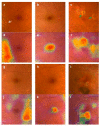Development of a Deep-Learning-Based Artificial Intelligence Tool for Differential Diagnosis between Dry and Neovascular Age-Related Macular Degeneration
- PMID: 32354098
- PMCID: PMC7277105
- DOI: 10.3390/diagnostics10050261
Development of a Deep-Learning-Based Artificial Intelligence Tool for Differential Diagnosis between Dry and Neovascular Age-Related Macular Degeneration
Abstract
The use of deep-learning-based artificial intelligence (AI) is emerging in ophthalmology, with AI-mediated differential diagnosis of neovascular age-related macular degeneration (AMD) and dry AMD a promising methodology for precise treatment strategies and prognosis. Here, we developed deep learning algorithms and predicted diseases using 399 images of fundus. Based on feature extraction and classification with fully connected layers, we applied the Visual Geometry Group with 16 layers (VGG16) model of convolutional neural networks to classify new images. Image-data augmentation in our model was performed using Keras ImageDataGenerator, and the leave-one-out procedure was used for model cross-validation. The prediction and validation results obtained using the AI AMD diagnosis model showed relevant performance and suitability as well as better diagnostic accuracy than manual review by first-year residents. These results suggest the efficacy of this tool for early differential diagnosis of AMD in situations involving shortages of ophthalmology specialists and other medical devices.
Keywords: age-related macular degeneration; class activation map; convolutional neural network; cross-validation; retina.
Conflict of interest statement
The authors declare no conflicts of interest.
Figures





Similar articles
-
Development of a Fundus Image-Based Deep Learning Diagnostic Tool for Various Retinal Diseases.J Pers Med. 2021 Apr 21;11(5):321. doi: 10.3390/jpm11050321. J Pers Med. 2021. PMID: 33918998 Free PMC article.
-
Automated Grading of Age-Related Macular Degeneration From Color Fundus Images Using Deep Convolutional Neural Networks.JAMA Ophthalmol. 2017 Nov 1;135(11):1170-1176. doi: 10.1001/jamaophthalmol.2017.3782. JAMA Ophthalmol. 2017. PMID: 28973096 Free PMC article.
-
Assessment of Deep Generative Models for High-Resolution Synthetic Retinal Image Generation of Age-Related Macular Degeneration.JAMA Ophthalmol. 2019 Mar 1;137(3):258-264. doi: 10.1001/jamaophthalmol.2018.6156. JAMA Ophthalmol. 2019. PMID: 30629091 Free PMC article.
-
From Data to Deployment: The Collaborative Community on Ophthalmic Imaging Roadmap for Artificial Intelligence in Age-Related Macular Degeneration.Ophthalmology. 2022 May;129(5):e43-e59. doi: 10.1016/j.ophtha.2022.01.002. Epub 2022 Jan 10. Ophthalmology. 2022. PMID: 35016892 Free PMC article. Review.
-
A Comprehensive Review of AI Diagnosis Strategies for Age-Related Macular Degeneration (AMD).Bioengineering (Basel). 2024 Jul 13;11(7):711. doi: 10.3390/bioengineering11070711. Bioengineering (Basel). 2024. PMID: 39061793 Free PMC article. Review.
Cited by
-
In-depth analysis of research hotspots and emerging trends in AI for retinal diseases over the past decade.Front Med (Lausanne). 2024 Nov 20;11:1489139. doi: 10.3389/fmed.2024.1489139. eCollection 2024. Front Med (Lausanne). 2024. PMID: 39635592 Free PMC article.
-
Development of a Fundus Image-Based Deep Learning Diagnostic Tool for Various Retinal Diseases.J Pers Med. 2021 Apr 21;11(5):321. doi: 10.3390/jpm11050321. J Pers Med. 2021. PMID: 33918998 Free PMC article.
-
AI-driven generalized polynomial transformation models for unsupervised fundus image registration.Front Med (Lausanne). 2024 Jul 16;11:1421439. doi: 10.3389/fmed.2024.1421439. eCollection 2024. Front Med (Lausanne). 2024. PMID: 39081694 Free PMC article.
-
A Comprehensive CNN Model for Age-Related Macular Degeneration Classification Using OCT: Integrating Inception Modules, SE Blocks, and ConvMixer.Diagnostics (Basel). 2024 Dec 17;14(24):2836. doi: 10.3390/diagnostics14242836. Diagnostics (Basel). 2024. PMID: 39767197 Free PMC article.
-
A multimodal deep learning system to distinguish late stages of AMD and to compare expert vs. AI ocular biomarkers.Sci Rep. 2022 Feb 16;12(1):2585. doi: 10.1038/s41598-022-06273-w. Sci Rep. 2022. PMID: 35173191 Free PMC article.
References
-
- Coudray N., Ocampo P.S., Sakellaropoulos T., Narula N., Snuderl M., Fenyo D., Moreira A.L., Razavian N., Tsirigos R. Classification and mutation prediction from non-small cell lung cancer histopathology images using deep learning. Nat Med. 2018;24:1559–1567. doi: 10.1038/s41591-018-0177-5. - DOI - PMC - PubMed
LinkOut - more resources
Full Text Sources

